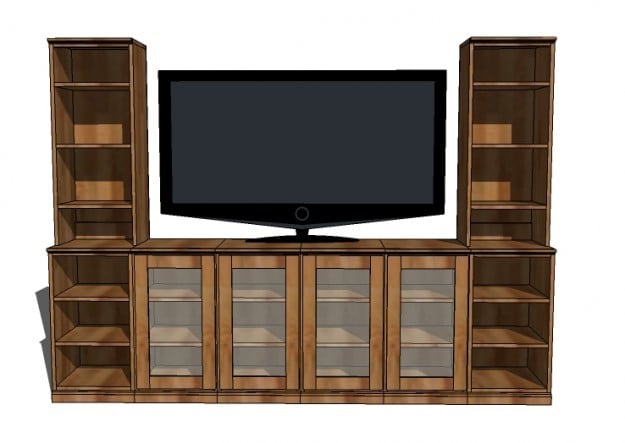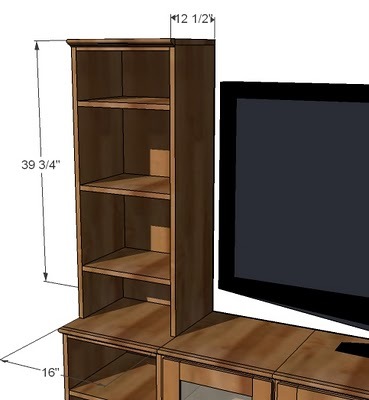
A basic bookshelf hutch for the Basic Collection.
By far my most favorite part of doing what I do is promoting the idea that anything is possible, if you are willing to work hard enough at it. I've always been a person that thinks how do I? instead of can I? - meaning everything is obtainable, it's just a matter of figuring out the how.
For most of us, myself included, being able to afford a $3,000 media suite is a distant dream, far behind our daily needs of diapers, dog food and possibly, dinner at a nice restaurant on special occasions. Who can justify spending that much, when kids need shoes and you could really use a good hairstyle? I certainly never could. So we saved and put our tv on the floor, thinking maybe someday.
But then I learned how easy it is to build something. Don't forget, furniture was built by hand long before it was built by factories. This collection, inspired by Pottery Barn's Printer Collection, is amazingly easy to build. And because it's modular, you can add as you go, build one piece at a time. Or reuse the pieces in an office, in the dining room, even in your bedroom.
You totally got this one! DIY Open Hutch Plans Inspired by Pottery Barn's Printer Collection
Oh, yeah - the new blog hopefully will be uploaded soon, so don't be alarmed if you check back on Monday and things look a little different.
Pin For Later!

Preparation
Please see PDF.
Please see PDF.
Please see PDF for full instructions.







Comments
Heather - Doll… (not verified)
Sun, 08/29/2010 - 06:56
Yay, Ana, your new home looks
Yay, Ana, your new home looks great! Congrats on your new design. :) xoxo Heather
Heather - Doll… (not verified)
Sun, 08/29/2010 - 06:57
home = site ;)
home = site ;)
ana (not verified)
Sun, 08/29/2010 - 19:01
Thanks Heather! It's so much
Thanks Heather! It's so much easier to keep tidy too LOL! Blogger was kind of like living in an apartment with no tools and a bad layout!
Linda (not verified)
Mon, 08/30/2010 - 03:35
Hi! Your new website looks
Hi! Your new website looks great! I'm having trouble finding the "cubby media wall" storage hutch system, inspired by PB. Could you please point me in the right direction? I can't wait to make all kinds of your projects! Thanks for sharing the plans!
ana (not verified)
Mon, 08/30/2010 - 08:11
Hi Linda, try this link
Hi Linda, try this link http://ana-white.com/category/plans/plancollections/cubby-wall-system-f… make sure you scroll down to see all the plans in the collection. Thanks for being a part of the new site!
Monica (not verified)
Mon, 08/30/2010 - 10:15
Hi, I'm from México and I
Hi, I'm from México and I make 2 furniture with your plans, for me is easier to send to your mail the photos, thank you so much for inspire me to build =D
Deb Weyrich-Cody (not verified)
Fri, 09/03/2010 - 18:20
Hi Anna, I can't tell you
Hi Anna, I can't tell you how nice it is to see the new site (sorry, been away for a while) and not get any grief from the comment box! Congratulations, everything is so nicely laid out and easy to use. ; )
Ana White (not verified)
Fri, 09/03/2010 - 18:50
Hi Deb, I was just thinking
Hi Deb, I was just thinking about you! I'm so happy you found our new site! Comment responses are so much easier now, it's unbelievable! I'm so glad you are here, for both me and other readers! Good to hear from you. Ana
Emily (not verified)
Tue, 09/28/2010 - 15:36
Love this plan! About how
Love this plan! About how much does this cost?
Bonnie (not verified)
Thu, 11/11/2010 - 09:23
Hi Ana. I am trying to
Hi Ana. I am trying to download all the plans for the Printer collection in preparation for when I get to the point of starting to make them. I downloaded in PDF format the open base with no prob. As I am not a facebook person, Scribd' is not being very friendly to me with allowing me to download this hutch in PDF. Is there some way that you can keep the option for downloading in PDF format w/o having to go through Scribd'? Thanks Ana!
Dezerae (not verified)
Thu, 02/02/2012 - 22:14
Quick Question
How would you attach this to the "Open Base" lol
Don Richards (not verified)
Tue, 07/24/2012 - 21:06
scribd?
Hello Anna,
I have downloaded the open base and would like to download the plans for this hutch to build them in the same weekend, however scribd wants me to pay for a membership in order to download the full plans... am I missing something?
Chaselby
Mon, 09/11/2017 - 09:23
Where can I download the plans?
Hi Ana, The plans are no longer on Scribd. Is there another link that I can use to download these plans?
Thank you!
In reply to Where can I download the plans? by Chaselby
Ana White
Wed, 09/13/2017 - 21:30
Here's this for now, will ask
Here's this for now, will ask Ana if she can help with the bookshelf/tower
section!
http://www.ana-white.com/2010/09/media-hutch-for-the-basic-collection.h…
Kind Regards,
Jen
---------- Forwarded message ----------
From: